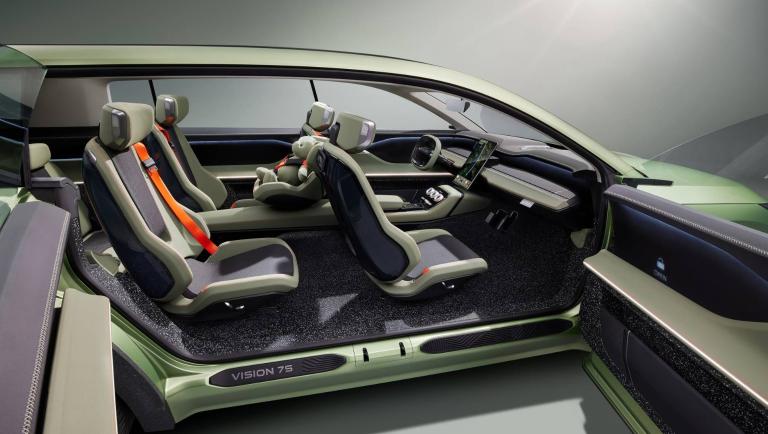Electric, digital, sustainable: ŠKODA defines its future
A new design language, anticipated by the VISION 7S concept, three new 100% electric models by 2026 and more on the way, a focus on digitalization and sustainability, a new logo and an updated corporate image: ŠKODA's plans for the future.
"With the VISION 7S concept, we are offering a concrete view of a completely new ŠKODA model that will expand our product portfolio and our customer base. We are thus significantly accelerating our e-mobility campaign: we are going to launch three new pure electric models by 2026 with more in the pipeline. This will put us in an even stronger position for the decade of transformation. In addition, we’ll be investing a total of €5.6 billion in e-mobility and a further €700 million in digitalization over the next five years, thus securing the future viability of the company and jobs.” So said Klaus Zellmer, CEO of ŠKODA AUTO, at the Explore More event, during which the Czech manufacturer revealed its vision for the future.

New BEV models
The acceleration concerns electric mobility in particular: three new all-electric models will be launched by 2026. In addition to a compact car, a compact SUV and a seven-seater family car are planned.
The VISION 7S concept, with an 89-kWh battery that allows a range of over 600 km and supports a peak charging rate of 200 kW, offers a specific preview of the seven-seater electric SUV. Following this, the BEV range will be further expanded. By 2030, ŠKODA AUTO aims to achieve a share of zero-emission models in Europe of more than 70%.

Many innovations
ŠKODA AUTO has created a new design language for the electric and digital age, which will gradually be rolled out starting next year. It is defined by clear, reduced lines that emphasise the simplicity and value of the new models. Characteristic elements include the new front end, with a so-called Tech-Deck Face, and sustainable materials in the interior.
The new brand logo will no longer use sculptural 3D graphics. The Corporate Identity (CI) has also been significantly revised; in terms of colour, ŠKODA AUTO will now use two different shades of green - Emerald and Electric Green, representing ecology, sustainability and electric mobility.
Top design and technology
The brand's new styling direction is anticipated by the VISION 7S concept. Based on the MEB modular platform, it clearly shows the design language that will become the trademark of future vehicles. Its foundation is a robust, authentic and functional look, while its distinctive feature is the Tech-Deck Face, a modern reworking of the traditional ŠKODA radiator grille. The new radiator grille is wider and flatter, with its ribs replaced by dark glass covering the car's sensors.
From a technical point of view, the VISION 7S has a cooling system specifically for the electric drive: the air outlets above the side skirts are covered by grilles and extract the air that heats up during battery cooling, while at the same time acting as a step for the folding doors. At the front there are seven vertical openings for extracting air for the radiator and brakes, as well as the orange lever (a colour that recurs frequently) for safely disconnecting the car's high-voltage circuit.

Sustainable finishes
The matt metallic paint finish in the Explorer Green colour is a further new feature introduced with the VISION 7S and emphasises its minimalist character, which is also found in the particularly spacious interior. The floor and boot are made of recycled-tyre veneer and the upper part of the dashboard is finished in dark eco-leather.
The lower parts are upholstered in a lighter shade of faux leather that picks up the colour of the bodywork. Finally, the fabric used in the interior, for example for the central part of the seats, the door panels or the dashboard, is made from recycled polyester yarns.
Sustainability along the entire value chain
ŠKODA AUTO is a strong advocate of sustainability along the entire value chain. For example, the company is committed to using electricity from renewable sources. In Mladá Boleslav, battery production, directly at the plant, ensures short transport distances for the two electric trucks used. From 2030, the Bohemian and Indian plants will produce cars with neutral net emissions. The Vrchlabí plant is leading the way; the site is already CO2-neutral since 2020.
ŠKODA is also committed to ensuring the sustainability in its products: an ENYAQ iV uses 13 kg of recycled plastic recovered from end-of-life battery cases and bumpers. The recycling rate for steel used in the body is 40% , while that of aluminium reaches 60%. The side windows are made of 20% recycled glass. In the interior, the ŠKODA ENYAQ iV also offers seat covers made of 40% virgin wool and 60% recycled PET bottles. At the same time, ŠKODA AUTO has enlisted the support of an external Sustainability Advisory Council to implement its ambitious sustainability goals. The five internationally experienced members provide new impulses and suggestions for current and future sustainability measures. In this way, they promote a more versatile dialogue on sustainability issues between the carmaker and its stakeholders.
Source: ŠKODA
VGI | Responsible OU: VP | Creation date: article date | Class 9.1
